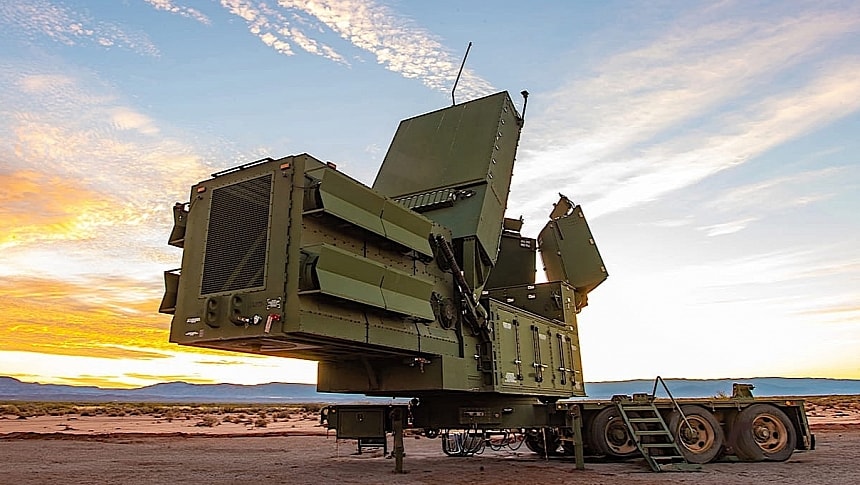Defense contractor Raytheon and the U.S. Army are currently hard at work testing a system they describe with no trace of modesty as the "world's most advanced and highly capable air and missile defense radar." Called LTAMDS, the system just passed another crucial milestone.
LTAMDS stands for Lower Tier Air and Missile Defense Sensor, and it has been in the works over at Raytheon for several years now, ever since the company was granted the contract to develop it. Since then, the radar has passed a total of four live-fire tests, each of them pitting it against a different kind of enemy.
The defense contractor just announced the most recent one. We are not told where or when exactly it took place, but the event marked the radar detecting, tracking, and engaging of a high-speed, high-altitude cruise missile surrogate that was flying in "an operational environment" and at a long and undisclosed range.
For the procedure, the LTAMDS was working in conjunction with the Integrated Battle Command System (IBCS). We're told the radar successfully acquired and tracked the target and then sent data about it to the IBCS.
Once that happened, the LTAMDS instructed a PAC-3 Missile Segment Enhancement (MSE) missile to fire and intercept the incoming threat.
This latest achievement comes on the heels of previous ones, which saw the system take on an air-breathing and a ballistic missile. Aside from U.S. Army representatives, military commanders from seven allied nations were on location to witness the procedure.
The LTAMDS has been designed as a defense system against a variety of threats. It however primarily targets missiles that fly faster than a mile a second, including aircraft.
The system detects them thanks to an array of three antenna arrays, with the primary located at the front of the radar and two additional ones at the back. This gives it the capability of looking at the sky in a 360-degree fashion. The range of the system is about 100 km (62 miles).
About the same size as the Patriot Air and Missile Defense System, the primary antenna of the LTAMDS has twice the power and can work with both the Patriot and the Integrated Air and Missile Defense system.
At the time of writing Raytheon has no less than six of these radars in various testing stages. Such procedures will continue throughout the year, with the company expecting to achieve "a 360-degree, full sector capability within the calendar year." The contract award for the six existing radars is estimated at $384 million.
The LTAMDS radars are the first in a series of a new family of such systems called GhostEye. Eventually, this new family is supposed to replace the radar system that currently guides Patriots.
The defense contractor just announced the most recent one. We are not told where or when exactly it took place, but the event marked the radar detecting, tracking, and engaging of a high-speed, high-altitude cruise missile surrogate that was flying in "an operational environment" and at a long and undisclosed range.
For the procedure, the LTAMDS was working in conjunction with the Integrated Battle Command System (IBCS). We're told the radar successfully acquired and tracked the target and then sent data about it to the IBCS.
Once that happened, the LTAMDS instructed a PAC-3 Missile Segment Enhancement (MSE) missile to fire and intercept the incoming threat.
This latest achievement comes on the heels of previous ones, which saw the system take on an air-breathing and a ballistic missile. Aside from U.S. Army representatives, military commanders from seven allied nations were on location to witness the procedure.
The LTAMDS has been designed as a defense system against a variety of threats. It however primarily targets missiles that fly faster than a mile a second, including aircraft.
The system detects them thanks to an array of three antenna arrays, with the primary located at the front of the radar and two additional ones at the back. This gives it the capability of looking at the sky in a 360-degree fashion. The range of the system is about 100 km (62 miles).
About the same size as the Patriot Air and Missile Defense System, the primary antenna of the LTAMDS has twice the power and can work with both the Patriot and the Integrated Air and Missile Defense system.
At the time of writing Raytheon has no less than six of these radars in various testing stages. Such procedures will continue throughout the year, with the company expecting to achieve "a 360-degree, full sector capability within the calendar year." The contract award for the six existing radars is estimated at $384 million.
The LTAMDS radars are the first in a series of a new family of such systems called GhostEye. Eventually, this new family is supposed to replace the radar system that currently guides Patriots.






